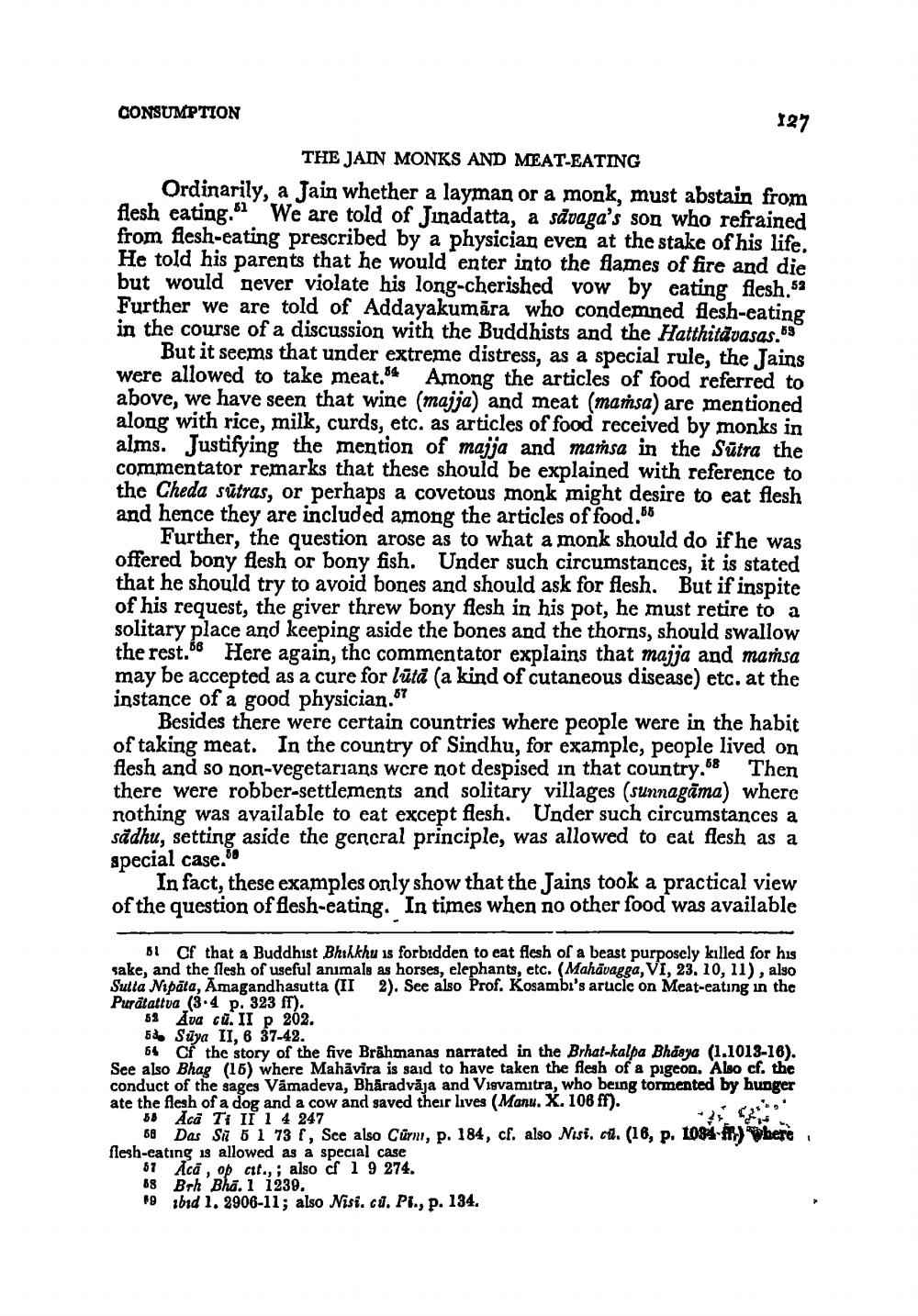________________
CONSUMPTION
127 THE JAIN MONKS AND MEAT-EATING Ordinarily, a Jain whether a layman or a monk, must abstain from flesh eating. We are told of Jinadatta, a săvaga's son who refrained from flesh-eating prescribed by a physician even at the stake of his life. He told his parents that he would enter into the flames of fire and die but would never violate his long-cherished vow by eating flesh.53 Further we are told of Addayakumāra who condemned flesh-eating in the course of a discussion with the Buddhists and the Hatthitavasas. 69
But it seems that under extreme distress, as a special rule, the Jains were allowed to take meat.04 Among the articles of food referred to above, we have seen that wine (majja) and meat (mansa) are mentioned along with rice, milk, curds, etc. as articles of food received by monks in alms. Justifying the mention of majja and maṁsa in the Sutra the commentator remarks that these should be explained with reference to the Cheda sutras, or perhaps a covetous monk might desire to eat flesh and hence they are included among the articles of food.65
Further, the question arose as to what a monk should do if he was offered bony flesh or bony fish. Under such circumstances, it is stated that he should try to avoid bones and should ask for flesh. But if inspite of his request, the giver threw bony flesh in his pot, he must retire to a solitary place and keeping aside the bones and the thorns, should swallow the rest. Here again, the commentator explains that majja and maṁsa may be accepted as a cure for lūta (a kind of cutaneous disease) etc. at the instance of a good physician.67
Besides there were certain countries where people were in the habit of taking meat. In the country of Sindhu, for example, people lived on flesh and so non-vegetarians were not despised in that country.68 Then there were robber-settlements and solitary villages (sunnagama) where nothing was available to eat except flesh. Under such circumstances a sådhu, setting aside the gencral principle, was allowed to eat flesh as a special case.
In fact, these examples only show that the Jains took a practical view of the question of flesh-eating. In times when no other food was available
01 Cf that a Buddhist Bhikkhu is forbidden to eat flesh of a beast purposely killed for his sake, and the flesh of useful animals as horses, elephants, etc. (Mahāvagga, VI, 23. 10, 11), also Sulla Nipāla, Amagandhasutta (II2). See also Prof. Kosambi's arucle on Meat-eating in the Puratattva (3.4 p. 323 fr).
5% Ava cū. II P 202. 5. Suya II, 6 37-42.
64 Cf the story of the five Brāhmanas narrated in the Brhat-kalpa Bhasya (1.1013-16). See also Bhag (16) where Mahavira is said to have taken the flesh of a pigeon. Also cf. the conduct of the sages Vamadeva, Bhäradvaja and Visvamitra, who being tormented by hunger ate the flesh of a dog and a cow and saved their lives (Manu. X. 106 ff).
58 Aca Ti II 1 4 247
58 Das SN 6 1 73 , Sce also Cūnı, p. 184, cf. also Nisi. ct. (16, p. 1084 fm) Where flesh-eating is allowed as a special case
87 Acă, op cit.,; also cf 1 9 274. 88 Brh Bhā.1 1239. 19 1bd 1. 2906-11; also Nisi. cd. Pl., p. 134.




